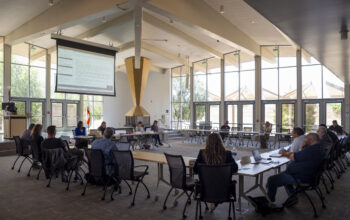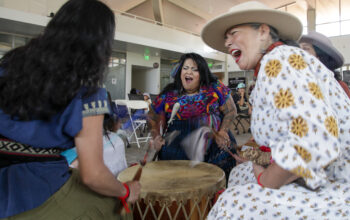Gary Moratz / Roundup
Polish your belt buckles and shine those boots, because the annual rodeo is coming back to Pierce College in 2011 for the first time since 2002.
Agricultural professor Ron Wechsler has been a big part of the intercollegiate rodeo since the ‘60s and has spearheaded the rodeo resurrection.
Wechsler, with the help of Tom Webb and Michael Brown, built the new arena spanning 160 feet wide and 270 feet long.
“This thing is built so perfectly that if we were off by an eighth of an inch anywhere the panels fit into the post, it wouldn’t work,” Wechsler said.
Webb, a former Pierce student, and Brown, a current Pierce student, volunteered countless hours helping Wechsler measure, weld and put together the arena, saving Pierce tens of thousands of dollars.
The arena has to be reinforced to handle the weight of a 2,200 pound bull running into it without it busting open.
“I guarantee you that if you hook a tractor to it with a chain, it’s not going to bend it,” Brown said. “This arena is going nowhere.”
Its first workout was Saturday, when Wechsler, Webb and Brown brought in more than half a dozen bulls and cows to test their structure.
“We needed to run the animals through to see where we needed to make adjustments,” Wechsler said. “We only had three spots to adjust which is amazing.”
Rodeo history at Pierce dates back to 1947 when students would ride dairy cows around before there was a real rodeo.
“In 1948, Professor John Barlow put together an actual rodeo team,” Wechsler said. “So they wouldn’t keep riding the expensive dairy cows.”
Barlow started the first Pierce intercollegiate rodeo in 1956 and it continued without a hitch until 1997 when it was cancelled due to low ticket sales.
It would have been the 41st annual event for the rodeo, which subsequently started up again the following year and continued until 2002.
The Pierce rodeo was one of the biggest events put on by the college, drawing crowds of more than 7,000 spectators and even a whopping $50,000 in proceeds one year.
Wechsler has great respect for Barlow, who was one of his mentors early on. Wechsler and Barlow were the two advisers who really put forth the efforts of the rodeo for many years together.
“If we could get this arena named ‘The John Barlow Arena,’ it would be the greatest thing in my life,” Wechsler said.
The event also brought out protesting organizations like People for the Ethical Treatment of Animals (PETA) and Animal Emancipation Inc.
Although they would come to most of the rodeo events at Pierce, there never was any major trouble with them and once the Sheriff’s department became the campus police, they stopped coming around altogether.
“I always invited them to come down and inspect the animals,” Wechsler said. “I tried to educate them but they weren’t interested in that.”
The animals are taken care of very well, receiving chiropractor work once a month along with other treatments including checking their teeth, hooves and even drawing blood to check for sickness or parasites.
Some of the animals can sell for more than a million dollars and cloning a bucking horse can bring in $250,000.
“One of the best examples I have ever seen was at the Denver Western National Stock show where they turned out seven generations of bucking horses, starting with the first one that is now 32 years old all the way down to a yearling,” Webb said.
Many of the bulls in the circuit are like star athletes drawing large crowds to see them in action.
“When they retire bulls at the professional bull rider’s circuit, there will be die-hard cowboys shedding tears,” Brown said.
The rodeo also has Amateur Day, which starts with a pancake breakfast and offers people not on the rodeo team steer riding, barrel races and other events. Everyone would then move to the stadium for wild horse racing.
Riders would do stunts like riding from one end of the arena at top speed and swing around another person who would stand at the other end of the arena, then pick them up so both would ride back just as fast in one continuous movement.
Winners of these competitions could earn Pierce belt buckles, which students wanted more than any trophy.
“The Pierce buckles were the most coveted buckles out of any school,” Wechsler said.
“They were made out of sterling silver and solid gold.”
The rodeo’s return is expected to take place around May 2011 and is greatly anticipated by Wechsler and his students. Anyone interested in learning more about the rodeo or animal sciences can contact Wechsler at 818-710-2980.

Michael Brown, equine science student, helps test the integrity of the rodeo arena Saturday. (Alina Popov / Roundup)

(Alina Popov / Roundup)



